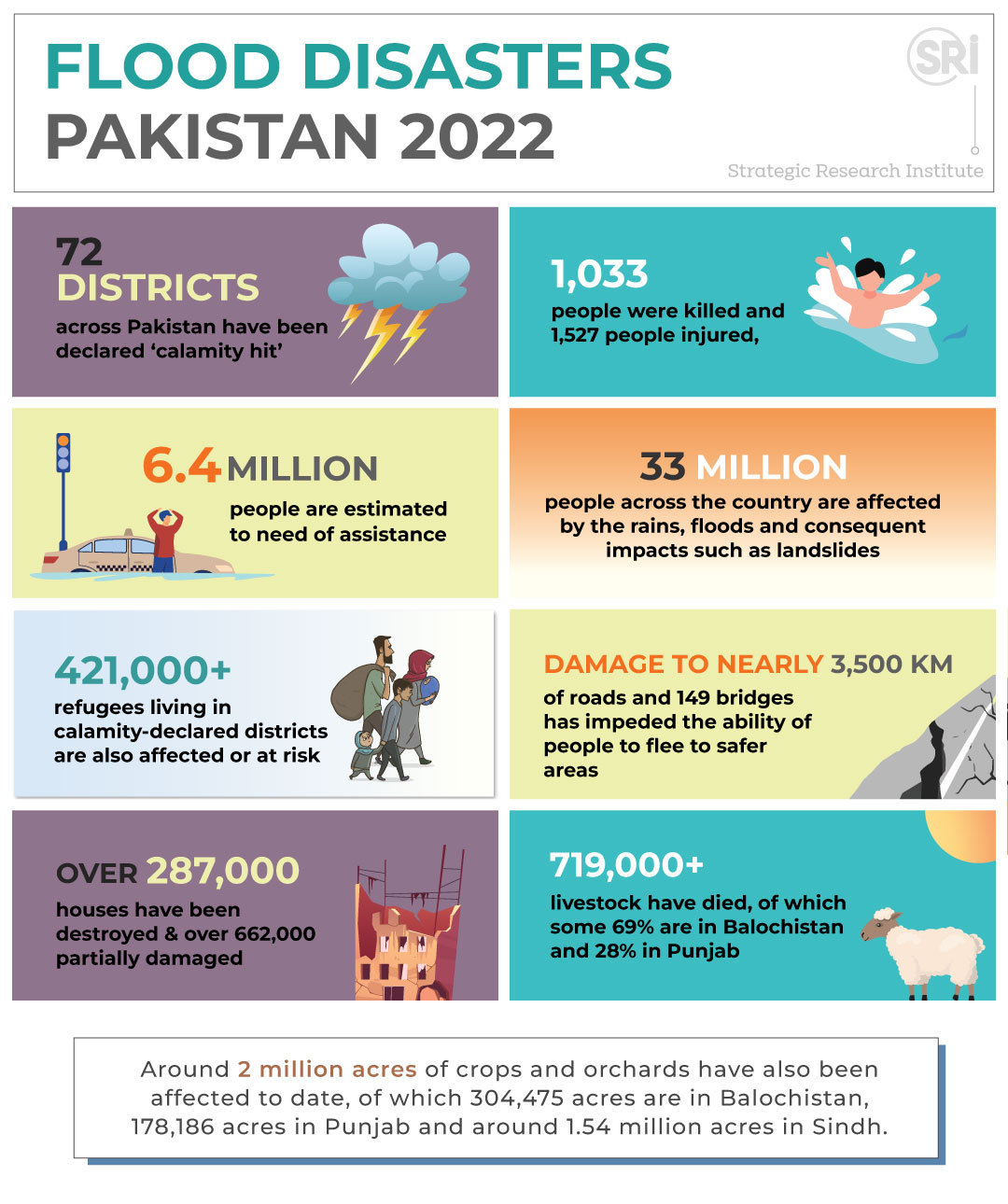A startling 1,033 people have died in the greatest floods in Pakistani history as of the last week of August 2022. The 2010 floods, which received extensive media attention for submerging villages, towns, and cities within days, pale in comparison to the enormous damage, human casualties, and crumbling status of the nation’s infrastructure. The situation in 2022 is nothing short of a humanitarian catastrophe, and humanity in Pakistan will suffer greatly if emergency actions are not carried out in full.
Except for Islamabad, no area has been spared; only the severity has varied substantially. The floods made life for many people living on embankments a horrible quagmire where relief efforts failed to ease the misery. Consider individuals who live in temporary structures or the homeless vagrants who support themselves by roaming and leading nomadic lifestyles. Khyber-Pakhtunkhwa (KP) and Balochistan, two of Pakistan’s poorest provinces, had to bear the brunt of the floods on their most vulnerable populations. In Pakistan’s biggest natural catastrophe in its 75-year history, river banks overflowed, inhabitants were evicted, and the abrupt surge of gushing waves targeted the weak. The Pakistani cricket team’s black wristbands, which they wore before their opening game against India in the 2022 Asia Cup, spoke volumes about the gravity of the situation.
The quagmire is a result of years of neglect and a lack of emergency preparedness on the part of provincial administrations. Consider Sindh, where the ruling class showed little concern for easing the suffering of the oppressed and where megacities like Karachi, which is home to millions of immigrants from all over Pakistan, were submerged in water. The tiny but poor population of Balochistan was also affected, as homes fell apart amidst terrifying scenes of mayhem. This disregard, a lack of urban planning, knowledge of the effects of rural-urban settlements, and the inability to create jobs for the poorer classes of society have all contributed to the current gloom. It is interesting that to remedy a policy gap that had significant ramifications for the average Pakistani, international donors, the United Nations, friendly Muslim nations, and China had to intervene.

Regarding climate change, Pakistan will never be safe from calamity owing to the melting of glaciers brought on by global warming and the increasing sea levels worldwide. The natural deterioration of an environment that formerly supported livelihoods and fostered better sustainability can be blamed for the bursting of barrages and bridges. Australia’s New South Wales floods show that climate change is a problem even in the driest parts of the world. For a nation that strongly depends on the Indus River for economic survival, rising water levels have a more serious effect. Now is the moment for all Pakistanis, regardless of caste, creed, religion, or political affiliation, to stand together and make substantial donations to reputable organizations to aid flood victims.
Read More: Apocalyptic Floods of Pakistan
If this catastrophe has produced any good, it has been the nation’s sense of oneness, which has been steady, resolute, and determined. Millions of individuals from all around the nation have kindly given and urged local authorities to take more action. With less focus on political vendettas and point scoring, the media has also been active in portraying the extent of the damage. It has also been noted how the devastating loss of the agricultural sector has caused donations to change from purely financial ones to ones that provide food and shelter to families who have seen their primary source of income go. If there is one critique, it is that despite the enormity of the work at hand and the lack of tolerance for complacency, national unity must be maintained. Pakistani civil society, which has frequently protested against human rights abuses, has to intensify its support for the victims of natural disasters so that there might be a noticeable impact.
What is certain, though, is that Pakistan’s whole terrain has been completely upended by the tremendous rains. Despite continued solutions and a common duty that all national stakeholders must now embrace, there is little relief. The ability to recover after being trapped will be a major test of character. The country has survived several calamities, crises, wars, and the scourge of terrorism. The situation of people left behind may be addressed via coordinated international and local initiatives, which is precisely what Pakistan needs right now.






